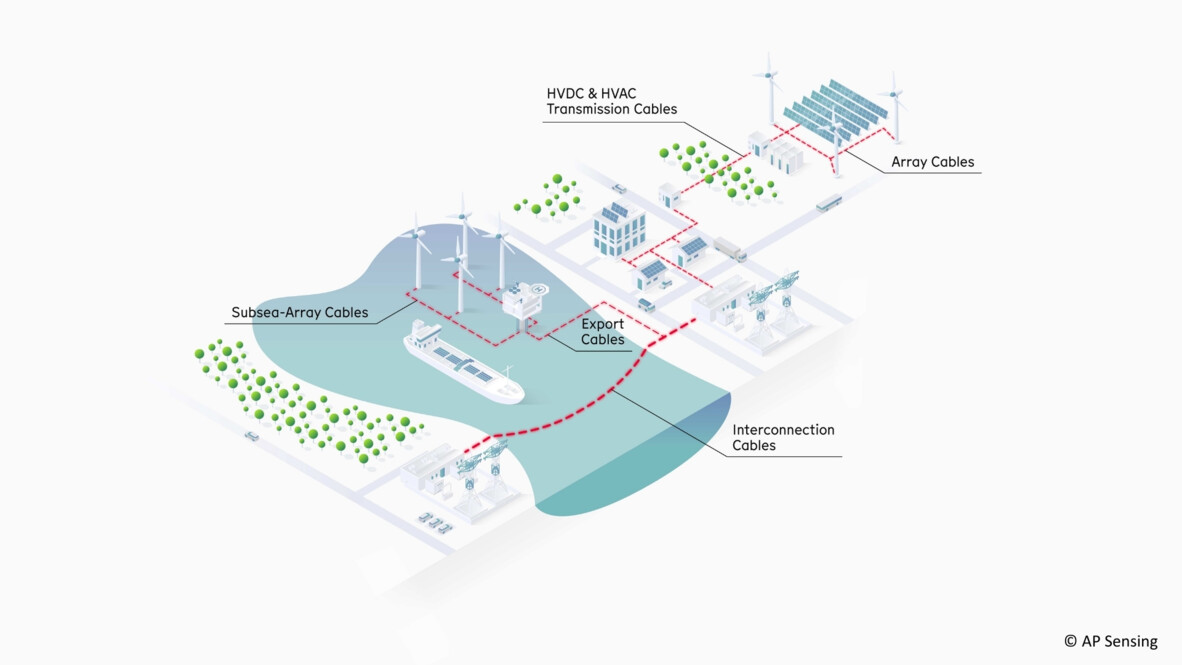Distributed Temperature and Distributed Strain Sensing systems (DTSS) measure temperature or strain along fiber optic cables for comprehensive asset monitoring. This technology provides precise temperature data for temperature monitoring or detects mechanical strain, enabling the identification of stress and potential deformations. By analyzing light interactions within the fiber optic cables, DTSS systems deliver real-time data, supporting preventive maintenance and corrective actions for critical assets such as power cables, pipelines, and infrastructure (i.e. bridges, dams and other buildings) , ensuring thermal stability and mechanical integrity.
How DTSS Works
Distributed Temperature & Strain Sensing (DTSS) utilizes standard optical fibers, often spanning dozens of kilometers, to monitor temperature or mechanical strain across an asset. These systems provides a spatially well-resolved profile, enabling real-time measurement of temperature or strain distributions with high accuracy, making it ideal for long infrastructure such as pipelines, power cables, and structural assets. A combination of temperature and strain sensing ensures comprehensive asset health monitoring, offering insights into both thermal and mechanical conditions with a resolution down to one meter along the fiber.
DTSS technology is based on Brillouin optical scattering, which responds to both, temperature and strain along the optical fiber. When a laser pulse is launched into the fiber, light is scattered back due to the interaction with the fiber material. The optical properties of the backscatter, such as frequency and amplitude, vary depending on the temperature and strain applied to the fiber. This data is continuously analyzed. The system uses optical time domain reflectometry (OTDR) to precisely locate where changes are happening by measuring the time delay of the returning signal, much like radar.
Brillouin Technology for Temperature & Strain Monitoring
In Brillouin-based DTSS systems, the backscatter signal properties depend on both, temperature and strain changes, making it possible to monitor both conditions. Analyzing temperature and strain effects along optical fibers enables early detection of potential risks, such as overheating, stress fractures, or mechanical deformations, ensuring the safety and longevity of critical infrastructure. This provides a holistic view of asset health, allowing for timely interventions and minimizing the risk of catastrophic failures.
Benefits & Advantages of Distributed Temperature & Strain Sensing
Distributed Temperature & Strain Sensing (DTSS) technology offers advanced monitoring capabilities by tracking temperature or mechanical strain along an optical cable , ensuring the reliability and safety of critical infrastructure assets.
Continuous Temperature & Strain Profile Measurement
DTSS systems provide continuous, real-time monitoring of thermal or strain conditions, allowing precise localization of anomalies such as hotspots or mechanical stress. Covering dozens of kilometers per measurement unit, these systems ensure comprehensive asset monitoring. For applications like power cables or pipelines, this capability allows for the early detection of temperature abnormalities or stress points, preventing costly damage or failure. Additionally, continuous thermal or strain data enables precise management of operations such as cool-down phases or stress relief in critical infrastructure.
Maximum Reliability Under Harsh Conditions
DTSS systems are designed to function reliably in extreme industrial environments, including those with high heat, dust, dirt, or corrosive elements. The optical fibers used are non-corrosive making them ideal for harsh environments. Depending on the fiber design and coating, DTSS technology can monitor a wide temperature range, while withstanding harsh mechanical stresses.
Immunity to Electromagnetic Interference
One outstanding advantage of DTSS systems is their immunity to electromagnetic interference (EMI), which is crucial for environments with high levels of electrical noise, such as power substations or industrial plants. As the sensors are optical, they are not disturbed by EMI or radio frequency interference (RFI), ensuring accurate and uninterrupted data transmission even in challenging electromagnetic environments. This makes DTSS systems a reliable solution for continuous monitoring in such conditions, providing undisturbed readings of both temperature and strain.
High Sensitivity and Accuracy
The sensitivity of DTSS systems ensures that even minor temperature or strain changes can be detected in real-time. This high level of accuracy is essential for applications where small variations can indicate critical changes, such as in pipeline or structural health monitoring. By detecting these changes early, DTSS technology enables predictive maintenance, improving the lifespan and safety of monitored assets.
Cost-Effectiveness and Low Maintenance Requirements
Cost-effectiveness and low maintenance requirements
DTSS systems offer significant cost savings compared to traditional sensor-based systems. Using a single passive optical fiber to monitor long distances reduces the need for multiple sensors and associated installation costs. The distributed nature of DTSS means that any point along the fiber is monitored equally, ensuring complete coverage without gaps. Furthermore, the low maintenance requirements of optical fibers contribute to long-term operational efficiency and cost-effectiveness, making DTSS a preferred solution for industries looking to reduce both downtime and maintenance expenses.
By leveraging these benefits, Distributed Temperature & Strain Sensing provides industries with a robust, reliable, and cost-effective monitoring solution for maintaining the integrity of critical infrastructure under thermal or mechanical stress.
Use Cases of DTSS Systems
Distributed Temperature & Strain Sensing (DTSS) systems are critical for real-time monitoring of thermal or mechanical stress in various infrastructure applications. Leveraging Brillouin-OTDR technology, DTSS systems provide comprehensive, high-precision data, ensuring asset safety, longevity and performance.
Key applications include:
- Power Cable Monitoring:
DTSS systems detect overheating and mechanical strain in underground or overhead power cables, preventing damage and ensuring reliability. - Pipeline Monitoring:
They identify temperature anomalies and mechanical strain along pipelines, enabling early detection of leaks or structural issues. - Geothermal Monitoring:
DTSS systems monitor thermal and mechanical changes in geothermal wells, helping manage pressure and temperature fluctuations for safe energy extraction. - Dike & Dam Monitoring:
These systems detect strain and temperature shifts in dam structures, offering early warnings of potential failures, detecting leakages and seepage. - Landslide Monitoring:
By detecting ground movement and stress variations, DTSS systems provide critical data for preventing landslides. - Structural Health Monitoring:
DTSS systems track strain and temperature in bridges, tunnels, and buildings, ensuring long-term structural integrity. - Well & Reservoir Monitoring:
In oil, gas, and water reservoirs, DTSS systems monitor thermal conditions and mechanical stress for optimized resource extraction. - Railway Monitoring:
DTSS systems identify thermal expansion and strain in rail tracks, maintaining track integrity and preventing derailments.
These applications ensure continuous, reliable monitoring of infrastructure, contributing to enhanced safety and operational efficiency.
With a proven track record and continued innovation, AP Sensing offers a completely integrated, end-to-end solution made in Germany. Our team works together with you to select the right combination of technologies to fit your requirements.
Key Takeaways
Distributed Temperature & Strain Sensing (DTSS) systems offer a comprehensive approach to asset monitoring by measuring temperature or mechanical strain over large distances. Utilizing Brillouin-OTDR technology, DTSS provides real-time data with high spatial resolution and measurement accuracy, enabling early detection of thermal anomalies or structural stress.
This makes DTSS suitable for a wide range of industries, including power cable, pipeline, and infrastructure monitoring. It enhances operational safety, prolongs asset life, and helps prevent failures, offering a reliable solution for maintaining the integrity of critical infrastructure.









